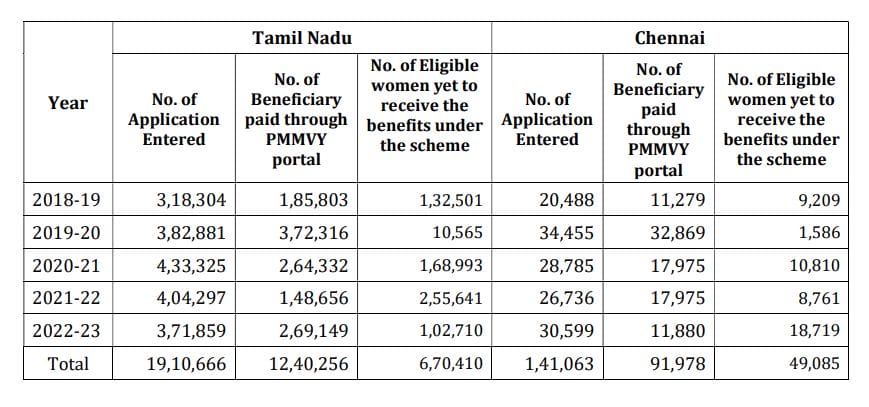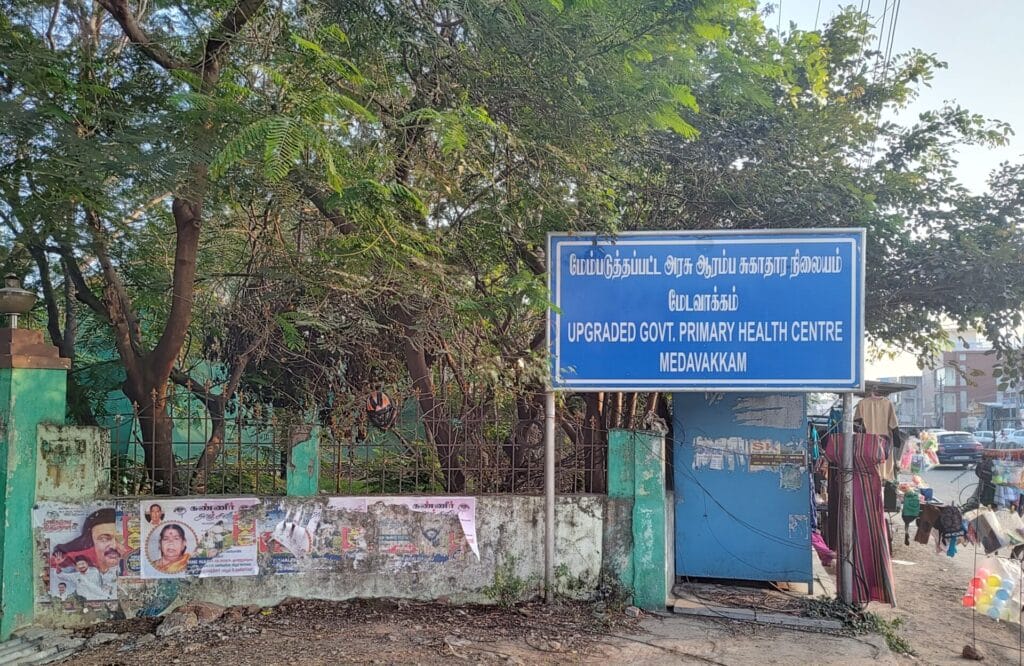It has been three years since M Sangeetha, a 25-year-old resident of Nanganallur delivered a girl at the Government Kasturba Gandhi Hospital for Women and Children in Chennai. Sangeetha is entitled to benefits under the Dr Muthulakshmi Reddy Maternity Benefit Scheme (Dr MRMBS)-Pradhan Mantri Matru Vandana Yojana (PMMVY), which provides cash benefits of ₹14,000 and health kits worth ₹4,000 to pregnant women in instalments.
Despite multiple enquiries with the Nanganallur Urban Primary Health Centre (UPHC), Sangeetha has not been able to access the benefits, even after submitting her address proof and supplementary documents. Her husband, a delivery agent, earns just enough to meet their basic needs. The challenges of COVID-19 hit her family hard, as her husband’s monthly income reduced by half. “I had to pledge my jewels to undergo monthly tests during the pregnancy. Had I received the monetary help from the government, my pregnancy would not have been a stressful period,” she told Citizen Matters.
Sangeetha’s case is not an isolated one. Of the nine women Citizen Matters spoke to in Chennai, only two had received full benefits on time. As many as six had partly received benefits under the scheme while one of them had not got even a single instalment.
In part 1 of the series, we presented a guide on how pregnant women can register their pregnancy in Chennai and sign up for the Dr Muthulakshmi Reddy Maternity Benefit Scheme (MRMBS). But here’s the question: Are mothers receiving the benefit on time?
In the second part of the series, we explore the problems and delay associated with the scheme and the effect of this delay on beneficiaries.
Read more: Hurdles faced by women seeking an abortion in Chennai
Too little, too late
Sangeetha was formerly employed in an entry-level position at a private company and had to leave her job because of pregnancy-related health issues, compounding the family’s financial struggles. She has spent ₹15,000 on crucial tests — Nuchal Translucency (NT) scan, Anomaly scan and other tests in private hospitals, apart from her monthly check-ups.
Wondering why she did not approach government hospitals? Because, government hospitals and PHCs do not provide copies of the ultrasound scan to patients and instead, give only written reports. This is also the reason why gynaecologists at government hospitals advise patients to obtain their scans from private centres.
Jeya Kumari, who worked as a domestic help in Perumbakkam, had to take unpaid leave for similar reasons, losing a monthly income of ₹7,000. Seven months into her pregnancy, she has been without work for the past three months. Expressing frustration, she says: “I did not receive a single instalment of the scheme despite registering with the Perumbakkam PHC on time.”
For women like Sangeetha and Jeya, who are clutching at straws, the amount from the welfare scheme can make a big difference to their quality of life. But, right now it seems like a never-ending wait.
Improving health indices
By focusing on improving birth weight rates and providing nutrition, MRMBS aims to improve health markers in the Below Poverty Level (BPL) category and acts as a poverty alleviation programme by providing wage loss compensation (Prabeena 2014), as mentioned in a study by the Baltic Journal of Law and Politics published in 2022.
While beneficiaries appreciate the scheme for alleviating financial burdens during pregnancy, a considerable number of pregnant women in Chennai are not receiving the benefits promptly. In many cases, women only receive health kits after delivery, whereas ideally, they should get them during the third and fourth months of pregnancy to enhance immunity. “What can I do with the health kit in the ninth month of pregnancy?” asks Sangeetha, who received the health kit in the final days of the last trimester.
Another mother Yuva Sree visited the upgraded Medavakkam PHC in early January to enquire about the status of the maternity scheme. Holding a child in her lap and another at her waist, she spoke to the village nurse, who assured her of prompt payment. Having delivered a boy in 2020, she received the instalments only towards the end of 2022. With the birth of her second son in April 2023, she is awaiting ₹8,000, highlighting the delays in the system.
Benefits aplenty
Tamil Nadu, which ranked 2nd in the country in healthcare, has been able to achieve the millennium development goals of reducing the Infant Mortality Rate and Maternal Mortality Rate through comprehensive coverage of maternity benefit schemes, explained the study by the Baltic Journal of Law and Politics.
Those who received the benefits utilised it completely. Sangeetha has received two monetary instalments for her second baby, whom she delivered in December 2023. She used the money to cover her monthly medical check-ups. “The ghee and dates in the kit are quite beneficial. I would not have been able to buy them on my own,” she said.
B Yuva Rani, a 29-year-old resident of Arasankalani, who delivered a boy in 2020 and a girl in 2023 is among the fortunate few to have received the monetary benefit on time. “I bought a ring for the boy and invested in Selva Magal Semippu Thittam for the girl,” she said. However, she received the health kit only in the ninth month of pregnancy for the first child and during the seventh month of pregnancy for the second time. “I did not receive ghee and dates the first time,” she recounted.
Read more: COVID-19: Pregnant women and senior citizens need extra measures of protection
Why the delay
The staff at PHCs face the daunting task of not only attending to patients but also regularly submitting the list of maternity scheme beneficiaries to the Department of Public Health (DPH). Short-staffed PHCs, despite their best efforts, struggle to keep up. This may result in a delay in expectant mothers getting the benefits to which they are entitled.
“In place of 20 doctors, there are only two for a population of one lakh. Ideally, there should be one PHC for 20,000 people, but in Chennai, there’s only one for a lakh people on average. Ensuring 100% implementation of any scheme is challenging,” said a doctor from a South Chennai PHC, on condition of anonymity.

Admitting delays in fund disbursement, a Block Medical Officer (BMO) said, “The State has not received Central government funds for the past two years. Many beneficiaries missed the first and third instalments. Hopefully, this may change as data entry operators at the district level were instructed to install a specific application in their systems in December 2023 to enter details of pending beneficiaries.”
Dr A R Shanthi, Secretary, Doctors’ Association for Social Equality (DASE), blames the Centre for the delay in disbursal, as a part of the benefit (₹3,000) comes from the Central government under the shared scheme. She has taken up this issue with the TN government multiple times. “I was told that there were issues in syncing the data of the beneficiaries with the State and Central government portals, which caused the delay,” she explained.
Whatever the cause of the lapse, it’s the pregnant women who are at a loss. Moreover, the MMR in Tamil Nadu has reduced only slightly in the last few years.
“Anaemia is high (52%) among women of reproductive age in Tamil Nadu as per the analyses of data from the National Family Health Survey (NFHS)-4 and NFHS-5 released in 2018 and 2020,” said Dr Shanthi, reiterating the potential the scheme has of reducing maternal anaemia.
A multi-crore project such as this scheme that has an annual budget of ₹800–₹900 crores in Tamil Nadu and more than 25,000 employees working at different levels, is bound to have challenges, says Dr T S Selvavinayagam, Director of Public Health and Preventive Medicine (DPH&PM). “Rather than point fingers at anyone, the directorate is working towards solutions such as mapping the localities, where pregnant women are residing and conducting surveys to ensure every beneficiary is covered under the scheme,” he told Citizen Matters.
For any grievances or for medical advice, the expectant mothers can call helpline numbers: 040-23462600/104.
Also read:
- What I observed during a day spent at a UPHC in Chennai
- Fever, BP or Diabetes? UPHCs in Chennai have you covered
